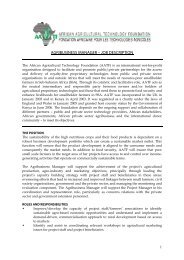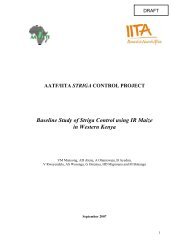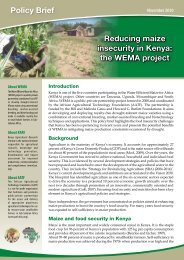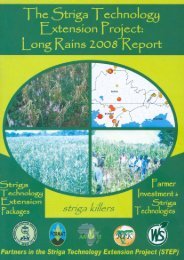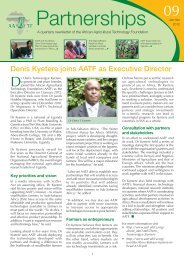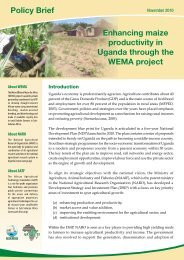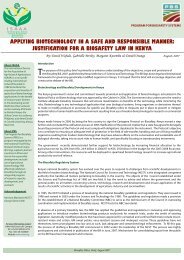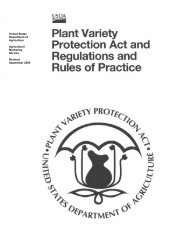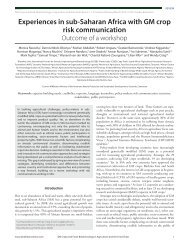A strategy for industrialisation of cassava in Africa - African ...
A strategy for industrialisation of cassava in Africa - African ...
A strategy for industrialisation of cassava in Africa - African ...
Create successful ePaper yourself
Turn your PDF publications into a flip-book with our unique Google optimized e-Paper software.
PROCEEDINGS OF A SMALL GROUP MEETING, 14–18 NOVEMBER 2005, IBADAN, NIGERIA<br />
Analysis <strong>of</strong> the status <strong>of</strong> <strong>cassava</strong> food sub-sector <strong>in</strong><br />
Nigeria<br />
Background<br />
Nigeria imports over one million tonnes <strong>of</strong> wheat every year. In the 1990s follow<strong>in</strong>g<br />
the depreciation <strong>of</strong> the value <strong>of</strong> the naira, the cost <strong>of</strong> wheat <strong>in</strong>creased substantially<br />
driv<strong>in</strong>g the cost <strong>of</strong> production <strong>of</strong> baked and other confectionary products beyond the<br />
purchas<strong>in</strong>g power <strong>of</strong> the majority <strong>of</strong> consumers. Wheat users started blend<strong>in</strong>g low cost<br />
non-wheat flour to br<strong>in</strong>g down their cost <strong>of</strong> production. The International Institute<br />
<strong>of</strong> Tropical Agriculture (IITA) developed a simple process <strong>for</strong> produc<strong>in</strong>g high quality<br />
<strong>cassava</strong> flour suitable <strong>for</strong> bak<strong>in</strong>g. The flour was successfully tested <strong>in</strong> bakeries and biscuit<br />
factories. Industrial users <strong>of</strong> <strong>cassava</strong> flour typically need large amounts <strong>of</strong> <strong>cassava</strong><br />
flour <strong>of</strong> consistent quality to meet all their needs. Quality specifications <strong>for</strong> high quality<br />
<strong>cassava</strong> flour are <strong>in</strong>dicated <strong>in</strong> Table 1. Emphasis on quality control and regularity <strong>of</strong><br />
the supply cannot be over-stated.<br />
Table 1. Specifications <strong>for</strong> high quality <strong>cassava</strong> flour<br />
Parameter<br />
Requirement<br />
Moisture 10%–12%<br />
pH 5.0–7.0<br />
Colour<br />
White<br />
Odour<br />
None<br />
Taste<br />
Bland or sweet<br />
Sand and other extraneous matter<br />
Absent<br />
Cyanide (maximum)<br />
10mg/kg<br />
Dimensions<br />
F<strong>in</strong>ely milled<br />
A 20% substitution <strong>of</strong> the national demand <strong>for</strong> wheat flour with <strong>cassava</strong> flour would<br />
require 240,000 tonnes <strong>of</strong> high quality <strong>cassava</strong> flour (assum<strong>in</strong>g the national demand<br />
<strong>for</strong> wheat flour is estimated at 1.2 million tonnes). S<strong>in</strong>ce one tonne <strong>of</strong> <strong>cassava</strong> flour is<br />
obta<strong>in</strong>ed from four tonnes <strong>of</strong> fresh <strong>cassava</strong> roots, the amount <strong>of</strong> roots necessary <strong>for</strong><br />
the substitution is about one million tonnes. Because <strong>cassava</strong> production is primarily<br />
done on small farms scattered around the country, <strong>cassava</strong> process<strong>in</strong>g should be done<br />
as near the farm as possible to avoid transport<strong>in</strong>g <strong>cassava</strong> roots over long distances.<br />
Also because <strong>of</strong> the difficulties <strong>of</strong> assembl<strong>in</strong>g large amounts <strong>of</strong> <strong>cassava</strong> roots, process<strong>in</strong>g<br />
should be done on a small scale <strong>of</strong> less than 10 tonnes per day. This implies sett<strong>in</strong>g<br />
up some 400 <strong>cassava</strong> flour process<strong>in</strong>g factories.<br />
11





